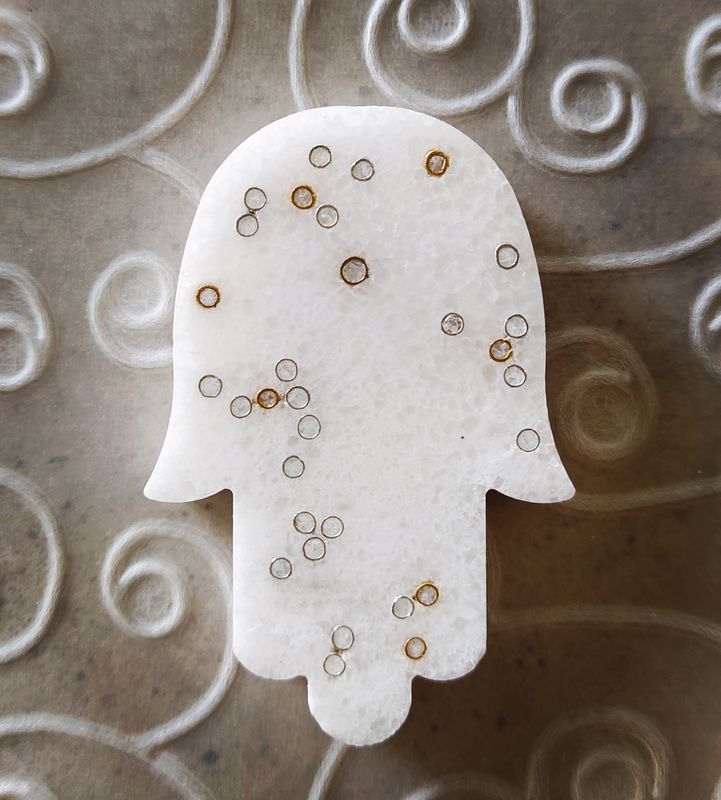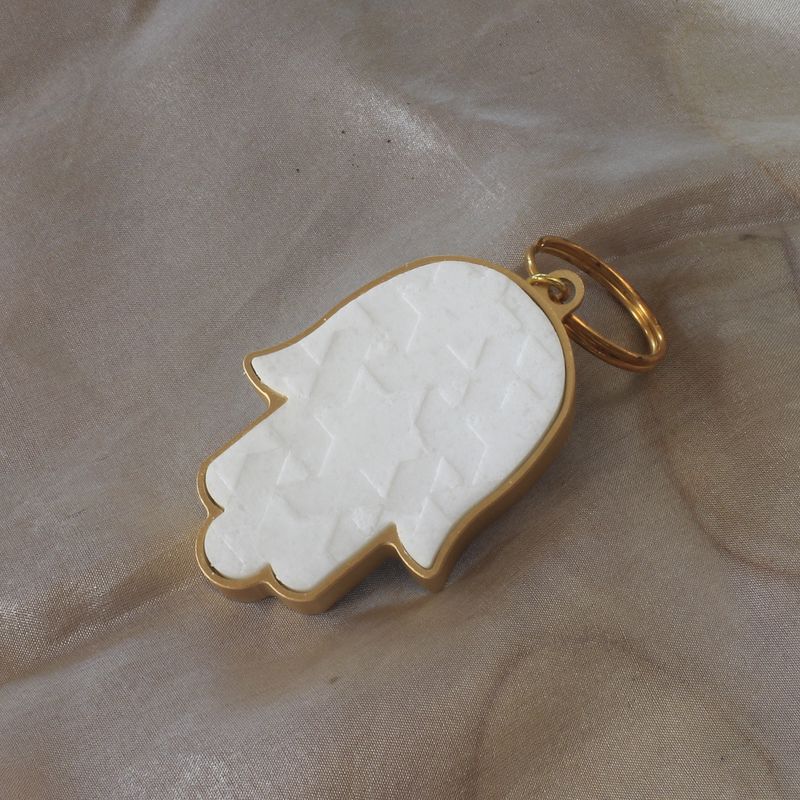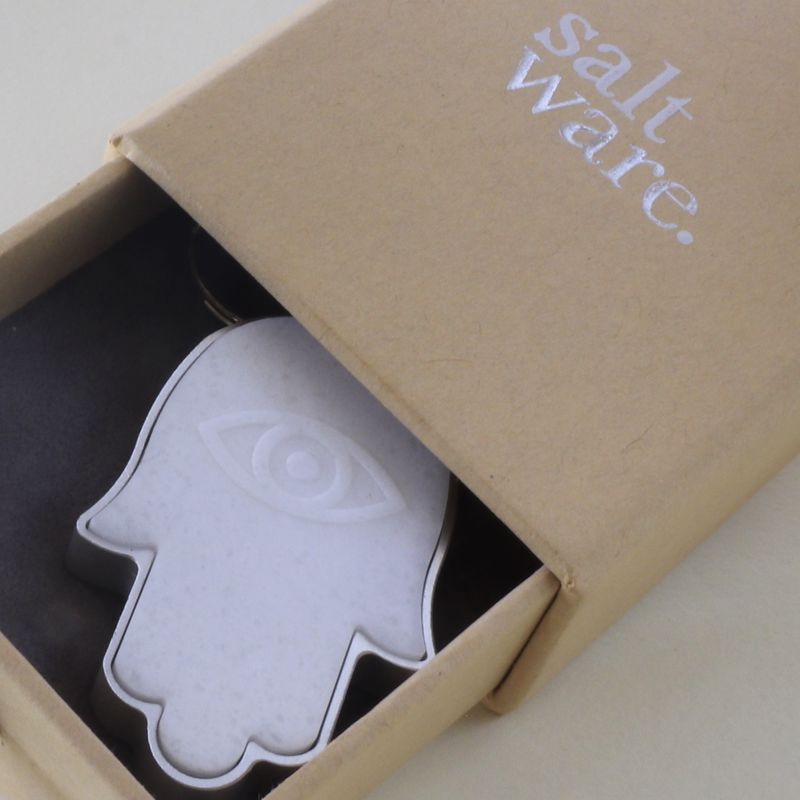Hamsa -The Ultimate Protection
What is the Meaning of Hamsa?
The Hamsa Hand is a palm shaped amulet, found throughout the Middle East and northern Africa, also known as a good luck charm, believed to confer protection upon its possessor and brings good luck, fertility and good health.
When the evil eye is added to the Hamsa ut is believed to protect from bad luck or the evil-eye with the most common being envious glares from those with ill intentions.
The Hamsa originated in the Middle East and is used in jewelry, paintings and tatoos. In fact, although the differences are sometimes subtle, each is created for a different purpose: a charm is worn to attract good luck; an amulet provides protection from danger; and a talisman is used to attract a particular benefit to its owner

Jewish Morrocan Hamsa, around 1900
The History of Hamsa hand
The Hamsa originated in the middle east and can be traced back to ancient Mesopotamia where it was worn as an amulet to protect against the evil eye.
The Pheonicians that travelled around the Mediterranean sea during 1500 to 300 BC used the symbol to represent Tanit, patron goddess of their capital city Carthage and controller of the lunar cycle. During the years the symbol transformed into a protective amulet to ward off the evil eye.
Hamsa a Symbol in the Largest Religions of the world The Hamsa Hand ‘Hand of Fatima’ in Islam
In Muslim culture, the hamsa is known as ‘The Hand of Fatima’. Fatima Al Zahra was the daughter of the Prophet Muhammad and his first wife, Khadija. ‘Al Zahra’ in Arabic is the shining one and Fatima is viewed as pure and without sin, The ‘Hand of Fatima’ is considered a symbol of protection, power and strength.
While Qu’ran law prohibits the wearing of charms and amulets, the Hamsa symbol is often depicted in and associated with Islamic cultures. Muslims refer to the hamsa as ‘Khamsa’, the Arabic word for five as well as the five fingers of the hand. The ‘Hand of Fatima’ symbolises the Five Pillars of Islam: Faith, Prayer, Pilgrimage, Fasting and Charity.
The Hamsa Hand in Judaism
The Hamsa hand symbol was adopted by the Sephardic Jewish community in Spain and North Africa during the middle ages. In the Jewish faith, the hamsa represents the hand of and named it the Hand of Miriam after the virtuous sister of Moses and Aaron.
Hamsa is also the Hebrew word for five (hamesh in Hebrew), the fifth letter of the Hebrew alphabet.
While some believe this represents the five fingers on the talisman, others associated it with the number five to represent the five books of the Torah: Genesis, Exodus, Leviticus, Numbers and Deuteronomy.
It also symbolises, “Hay”, which represents one of God’s holy names, and further reminds Jews to use their five senses when praising God.

The Hamsa ‘Hand of Miriam’ in Judaism
Hamsa Hand in Hinduism
To Hindus believers it became a presentation of the five chakras.
With the discovery and spread of ethnic styles world-wide the Hamsa Hand was adopted by all spiritual believers. Thus made it one of the richest and diverse designed symbols around the world.
In Hinduism, the hamsa takes on a very different meaning. For Hindus the hamsa represents the chakras, the five senses and their associated mudras (hand gestures) that re-direct energy flow throughout the body.
- Thumb – Fire element / solar plexus chakra.
- Forefinger – Air element / the heart chakra.
- Middle Finger – Ethereal elements / throat chakra
- Ring Finger – Earth element / root chakra
- Pinkie Finger – Water element / sacral chakra
Hamsa Jewelry
The Hamsa today is popular as a protective charm in Middle Eastern, Far Eastern and Western cultures, and is incorporated into jewellery, wall hangings, key chains, baby carriages and other jewellery and decorative household elements.
The Hamsa appears in two forms: stylized with two symmetrical thumbs and asymmetrical, with a clearly defined thumb and pinkie finger. Either form may be displayed with the fingers pointing up or down. The centre of the hand often contains further symbols, especially that of an eye, however different cultures may fill the hand with images relevant to them. Most Hamsa jewellery designs are made of silver, gold or other metals.

Hamsa made of Dead Sea Salt
Hamsa and Salt
Salt has been a preservative substance in ancient rites and evolved to a symbol of protection and deep friendship in many religions and cultures.
It is a cross-culture substance of purity and high morals, from western Chritian culture (Salt of the Earth) to Far-Eastern Japanese culture (Morishio).
Saltware’s Hamsa is made of salt from the Holy Land and is a unique
one-of- a-kind artefact. The two long-heritage deep meanings are combined to create a beautiful variety of talismans. A combination of heaven and earth, natural materials and artisan skill.
Who can wear a Hamsa?
In middle eastern societies it is very common to find men wearing large statement style Hamsa pendants.
In western societies it is mostly common in women’s jewellery design.Hamsa is common in many more designed objects like key chains, wall ornaments and textiles where it is used regardless to sex, colour and religion😊

Hamsa jewellery is popular as a protective charm
Hamsa as a Symbol of Human Unity
The Hamsa is in the process of transcending its origins of being a talisman that is thought to have protective qualities to become a gesture of hope for peace in the Middle East. Many Jews and Arabs wear and decorate the entrance to the home with the Hamsa to demonstrate the common ground shared by them, the common source from which their religions spring and to symbolise the common goal of peace in the region.
